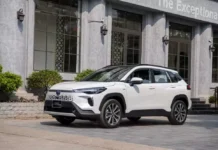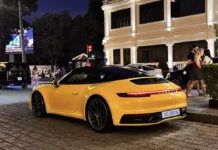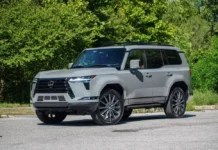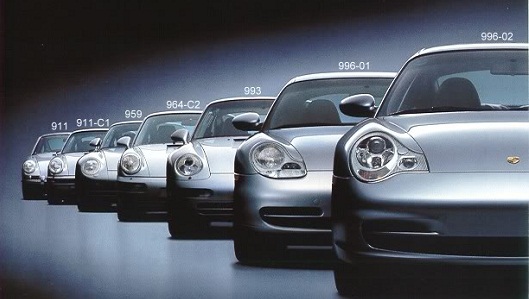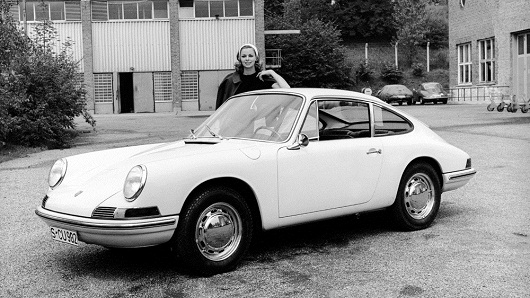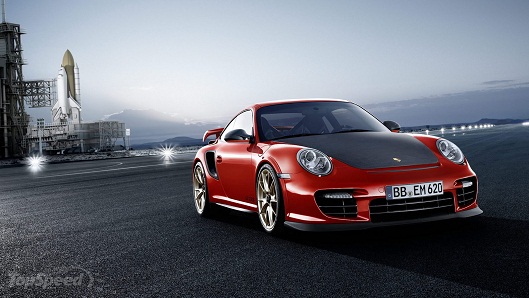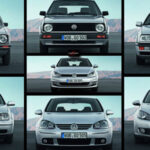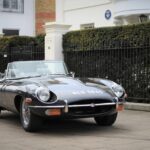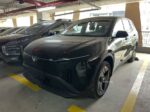The 911, after a decade of existence, continues to be an iconic symbol and the essence of the Porsche brand. There are few cars in the world that can rival the 911 in terms of its rich history and the continuity of its vehicle line.
>> Celebrating 50 years of inspiration with the Porsche 911
The first 911 (introduced in 1963) – the beginning of a legend
Following the success of the Porsche 256, the 911 generation captured the hearts of sports car enthusiasts from the first glimpse. The initial prototype was unveiled in 1963 at the Frankfurt Motor Show (IAA) under the name 901 and was later renamed the 911, officially entering the market in 1964.
Powered by a horizontally opposed 6-cylinder air-cooled engine producing 130 horsepower, the car achieved a top speed of 210 km/h. For those seeking slightly lower speeds, the Porsche 912 with a 4-cylinder engine was also available. In 1966, Porsche introduced the 911 S with a 160-horsepower engine and alloy wheels from Fuchs.
The subsequent notable generation was the 911 Targa, which featured a distinctive stainless steel roll bar and debuted in 1966 as the world’s first safety convertible coupe. In 1967, the 4-speed Sportomatic semi-automatic transmission was introduced. The same year, with the 911T followed by the E and S models, Porsche became the first German car manufacturer to comply with strict US emission regulations. As the years went by, the 911’s engine capacity increased significantly, from 2.2 liters in 1969 to 2.4 liters in 1971.
The 911 Carrera RS 2.7, introduced in 1972 with a 210-horsepower engine and weighing less than 1 ton, remains an iconic dream car to this day. The car was also equipped with the first rear spoiler on a production vehicle, famously known as the “ducktail”.
The G-Series (introduced in 1973) – The second generation
Ten years after the birth of the legendary model, Porsche engineers took the 911 to new heights. The G version was produced from 1973 to 1989, making it the longest-running 911 generation at that time. The car featured a prominent rear bumper, which was an innovative design to comply with stringent US safety standards.
The seats were equipped with standard three-point seat belts and comfortable headrests. Returning to the iconic 911 generations, one of the significant milestones was the introduction of the 911 Turbo with a 3-liter engine delivering 260 horsepower and a large rear spoiler. This model truly brought the Porsche brand into the spotlight with its outstanding design, luxurious features, and performance.
In 1977, the 911 Turbo 3.3-liter model was introduced, featuring a unique cooling system and a performance capability of up to 300 horsepower. In 1983, the 911 Carrera officially replaced the previous versions. With a 3.2-liter engine delivering 231 horsepower, the car became a passion and a coveted collector’s item.
In 1982, the Cabriolet version was introduced to meet the demands of convertible enthusiasts. Finally, in 1989, the 911 Carrera Speedster was born, developed from the legendary 356 prototype of the 1950s.
The 964 (introduced in 1988) – A blend of classic and modern style
When automotive experts predicted the end of an era, Porsche introduced the 911 Carrera 4 (Model 964) in 1988.
After almost 15 years of production, the 911 generation received a facelift of 85% to ensure Porsche’s lineup kept up with the trends. The horizontally opposed 3.6-liter, air-cooled engine provided 250 horsepower, remaining at the heart of its technological advancements.
In terms of exterior design, the 964 model differed slightly from its predecessors with its aerodynamic shape and self-adjusting rear spoiler. The interior presented a completely different story, designed to provide a sporty yet comfortable driving experience.
The car came equipped with an ABS anti-lock braking system, Tiptronic transmission, power steering, and combined airbags. The chassis underwent a complete redesign, featuring lightweight aluminum joints and coil springs instead of the previous torsion bar suspension system. The 911 Carrera 4 with all-wheel drive represented a significant leap in the 911 series since its launch.
In addition to versions such as the Carrera Coupe, Cabriolet, and Targa, customers could also order the 964 Turbo starting from 1990. With an upgraded engine from 3.3 liters to 3.6 liters, the car was capable of delivering up to 360 horsepower. Today, models such as the 964 Carrera RS, 911 Turbo S, or 911 Carrera 2 Speedster continue to be highly sought after by car collectors.
The 993 (introduced in 1993) – The final air-cooled versions
The 911 model with the internal code name 993 remains the eternal love of many seasoned Porsche drivers. Its excellent design is one of the main factors contributing to its popularity. The oval-shaped headlights with distinct light points on the front cover were a familiar sight for previous 911 models, but the 993 had even more to offer.
The 993 model quickly gained a reputation for its exceptional reliability. It was also during this generation that cars with aluminum frames began to make their appearance. The Turbo model was the first gasoline-powered car to feature a variable turbo with variable vanes, significantly reducing emissions compared to other cars of the time. Additionally, the hollow aluminum rims were an innovation exclusive to this special Turbo model.
Speed enthusiasts yearned for the 911 GT2, which offered an intensified engine power experience. The 993 generation also introduced an electrically operated roof window under the car’s roof for the 911 Targa model. However, what Porsche enthusiasts remember most about the 993 generation produced from 1993 to 1998 is that it was the last air-cooled version of the 911.
The 996 (introduced in 1997) – Water-cooling system
The 996, with its internal code 996, began production in 1997 and ended in 2005, representing the most significant technological change in the history of the 911. It retained all the captivating features of previous versions, while bringing something completely new and unique to the table – a water-cooling system. Thanks to the inline 4-cylinder engine, the car could deliver up to 300 horsepower and set records for fuel efficiency, reduced emissions, and noise.
The exterior design still showcased the iconic lines of the 911 but with a low drag coefficient of 0.3 cW. The seamless fusion of the 996’s lines with the successful Boxster convertible sports car was nothing short of exquisite. The integrated headlights with turn signals stirred up much debate but went on to inspire countless other car brands to follow suit.
Inside the cockpit, drivers were treated to an entirely new space. Comfort was paramount, and Porsche ensured it was not compromised in favor of sporty features. Overall, the 996 sparked a revolution for Porsche, introducing numerous innovations to the 911 lineup. The highlight of the 911 series from 1999 became the 911 GT3, which beautifully embraced the cherished values of the Carrera RS generation. In the fall of 2000, the 911 GT2 took the spotlight as the first car equipped with ceramic brakes as standard, solidifying its status as an outstanding sports car.
The 997 (introduced in 2004) – Classic and modern side by side
In July 2004, Porsche unveiled the new 997 generation, featuring the Carrera and Carrera S models with an internal code number of 997. While the oval-shaped headlights with distinctive light points on the front spoiler were reminiscent of previous 911 models, the 997 offered much more.
The 3.6-liter engine delivered 325 horsepower, while the Carrera S version packed even more power with a 3.8-liter engine producing 355 horsepower. The chassis was also significantly improved, featuring Porsche’s Active Suspension Management system (PASM) as standard. In 2006, Porsche introduced the 911 Turbo, the first gasoline-powered car to be equipped with a turbocharger with variable turbine vanes.
Further improvements came in the fall of 2008, with the introduction of direct fuel injection and a dual-clutch transmission for the 997. The 911 family had never offered such a wide range of options for customers, including variations like Carrera, Targa, rear-wheel drive or all-wheel drive, Turbo, GTS, special editions, and road-going versions of GT racing models. In total, the 911 “family” had 24 different members.
The 991 (introduced in 2011) – Changes for an immersive experience
The 991 model represented the most significant technological leap in the history of the 911 series.
Building upon the values of the iconic sports car over many decades, the new 911 generation elevated performance and capabilities to new heights. With a completely redesigned suspension system boasting a longer wheelbase, wider chassis, larger wheels, and scientifically designed interior, the 911 delivered a sportier driving experience and heightened comfort. Technologically, the 911 embodied Porsche’s philosophy of “Intelligent Performance” – consuming less fuel while maintaining exceptional performance. This was achieved through the inclusion of a 3.4-liter engine in the base Carrera version (generating over 5 horsepower more than the 997/II model) and the combination of iron and aluminum in the vehicle’s structure to reduce weight significantly.
Further improvements included Porsche Dynamic Chassis Control (PDCC) and the introduction of the world’s first 7-speed manual transmission. The 991’s design met the highest market demands, with its elongated and flat silhouette, captivating lines, and precisely designed details positioning the 7th generation Porsche 911 Carrera as an unmistakably successful embodiment of sports car design. Until the arrival of subsequent generations, the 991 remained the closest thing to perfection within the 911 series – a source of pride and a symbol of Porsche’s excellence worldwide.
Hoang Tuan (TTTD)



























